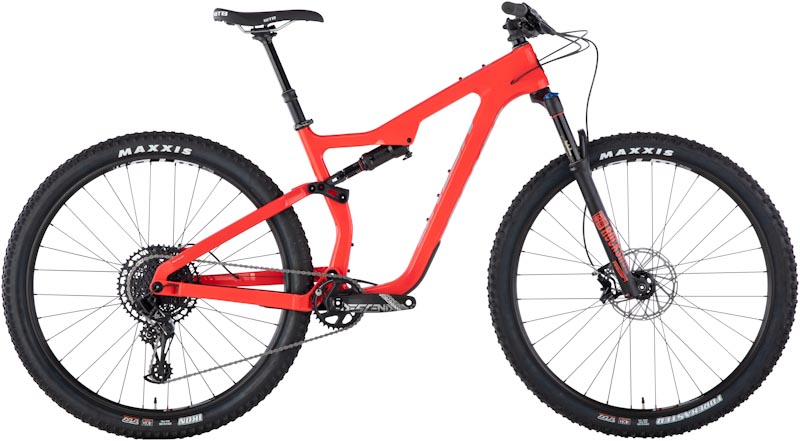If you were to design a bike specifically for a 50-mile race that’s mostly comprised of singletrack trails, I bet it would look something like Salsa Cycles’ Spearfish. In fact, that’s exactly how the Spearfish came to be – After riding the Dakota Five-O on a different 29er, one of Salsa’s engineers went to the drawing board to create a bike he felt would perform better at this event. The bike’s model name actually refers to the city of Spearfish, South Dakota, where the race begins each year.
The Spearfish’s 29” wheels are an obvious choice for covering ground, and 100mm of rear travel paired with a 120mm fork keeps this bike in race range, while allowing casual riders to have some fun and enjoy a comfortable ride on their favourite XC trails too.
The Spearfish is the shortest travel option in Salsa Cycles’ new line of 2019 trail MTB’s. During the launch event, I got to ride the Spearfish Carbon NX Eagle on moderately technical sections of Arizona’s Black Canyon Trail. Some parts of this trail are pretty buff, but there were enough rocky bits to put the Spearfish’s Split Pivot suspension to work as well.
The Spearfish is the shorter travel brother of Salsa’s Horsethief (a 120/140mm do-it-all niner), and its frame geometry is a bit more cross-country focused. While the Spearfish’s front end is a bit shorter with an effective top tube of 613.5mm, its reach is roughly 7mm’s longer at 441.6mm. Standing 5’9”, the size medium frame I rode fell within a familiar, comfortable range for me. Despite the bike’s XC-leaning, it doesn’t feel drastically longer and lower than the Horsethief up front. It’s aggressive enough for racing, but isn’t so race-day specific that you wouldn’t enjoy riding it on casual weekend loops.
The Spearfish’s head tube angle is 67.8°, which allows for pretty agile handling on the trail. Its seat tube angle of 74.4° is quite steep, making it no problem to put power down on the pedals. In Low position (as ridden) the Spearfish’s BB drop is 39mm, but if you’re riding rougher terrain you can gain about 4mm more ground clearance by flipping the chip in the rear shock mount. Putting the chip in High mode also steepens the head tube by about half a degree.
The Spearfish has moved to 157mm rear spacing for 2019. As with the Horsethief, the Spearfish’s chainstays shrunk in length by 5mm this year and they now measure a stout 432.4mm. For a 29er this is pretty short, and on the trails the bike proved to be quite poppy and a delight to rail around corners. Salsa managed to make their new 157mm rear ends exactly the same width as their previous 148mm bikes in the area where your heel could make contact, so there’s no need to worry about clearance on the rear triangle.
Like the Rustler and Horsethief, Salsa’s geometry is very well balanced on the Spearfish. Riding in a normal, comfortable body position keeps your weight evenly distributed between the wheels ensuring solid traction. A slight rock of your hips is all it takes to move weight forward for steep climbs, or backward to rally downhill.
If you want to build a solid race car, it’s best to start with a good chassis. Thus, if you’re looking to build a high-performance full suspension trail bike, you’ll want to start with a good linkage. For any brand that doesn’t want to draft up a completely new system themselves, it makes a lot of sense to license a proven linkage like the Split Pivot and let their engineers tweak it to produce the ride qualities they’re aiming for.
Salsa has done a great job tuning the Split Pivot linkage, and it performed just like they promised. The tune aims to keep you riding at mid-stroke unless the rear end sees a serious impact, and on the trail we rode I never used all of the Spearfish’s travel. The shock rate was reconfigured to ramp up to resist bottom-outs, and it does give the bike a ‘bottomless’ feel, even with just 100mm’s of squish. Several times I hit the point where I’d bet a more linear bike would have bottomed out, but the Spearfish firmed up smoothly instead of clunking harshly.
Another thing this linkage does very well is keep your rear wheel glued to the trail. I rode with the Rockshox Deluxe RT3 shock in wide open mode, and it used most of the shock’s travel to reliably claw the bike up rougher, rocky pitches. Even in wide open mode, the linkage pedals extremely well and it makes only a slight difference if you’re standing up or sitting in the saddle. Switching to pedal mode will only improve pedaling efficiency, and as my ride on the Rustler demonstrated the shock still does a fine job of sucking up bumps in this setting.

The Spearfish’s component spec shows its cross-country roots. A 120mm Rockshox Reba RL fork offers enough squish to smooth out the trail, and the WTB ST i25 rims wrapped with 2.35” Maxxis Forekaster tires keep the wheels on the slim side. SRAM’s Guide T brakes bite a 180mm front and smaller 160mm rear rotor, and their NX Eagle 12-speed drivetrain provides all the gear range anyone should need. Salsa kept a 125mm dropper post on this bike which keeps it versatile, and of course, helps any rider tackle steep descents.
As tested, the Spearfish Carbon NX Eagle retails for $4,199. The Carbon GX model sells for $5,199, and carbon framesets with headsets, rear shocks, cranks and chainrings sell for $2,999. Complete aluminum models range from $2,399-2,999.








